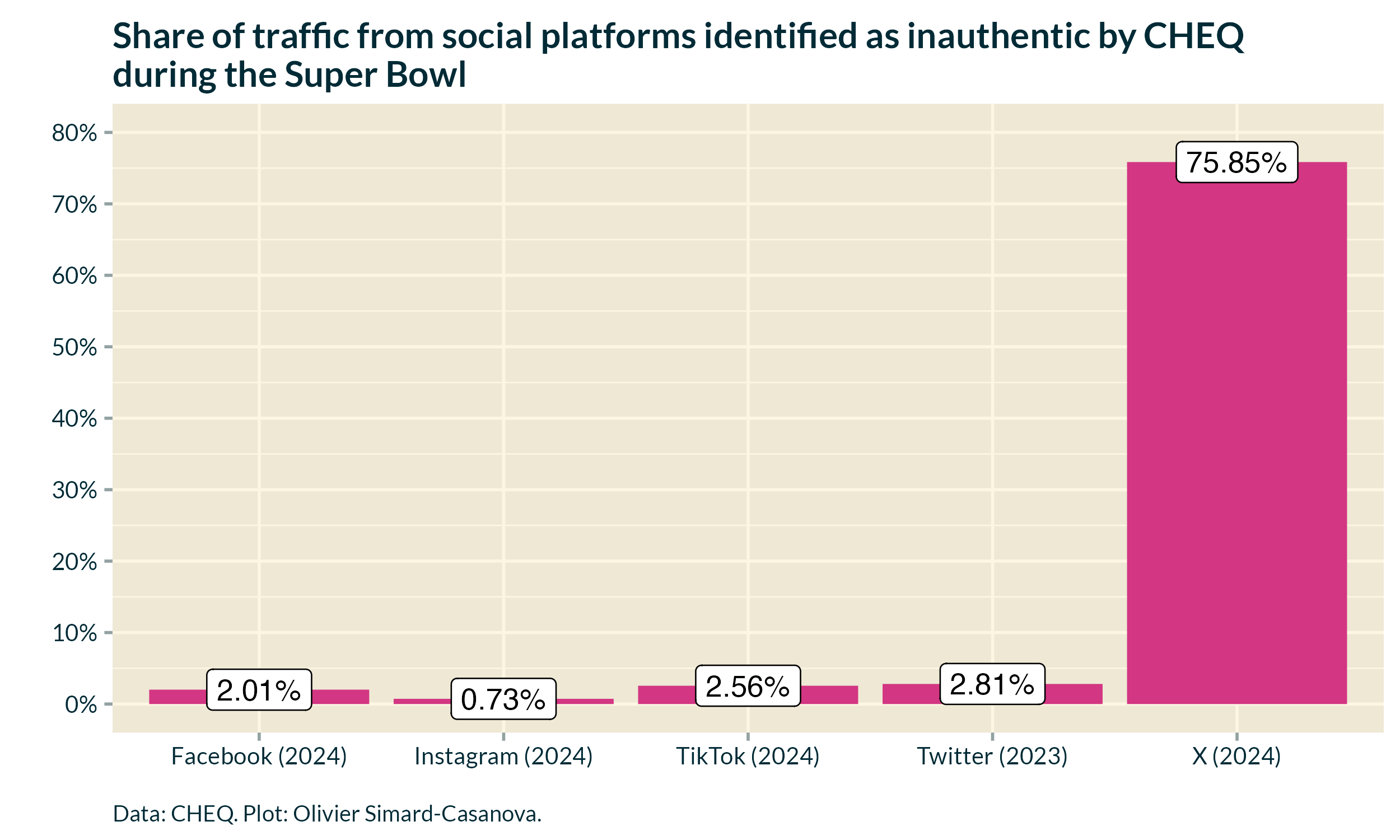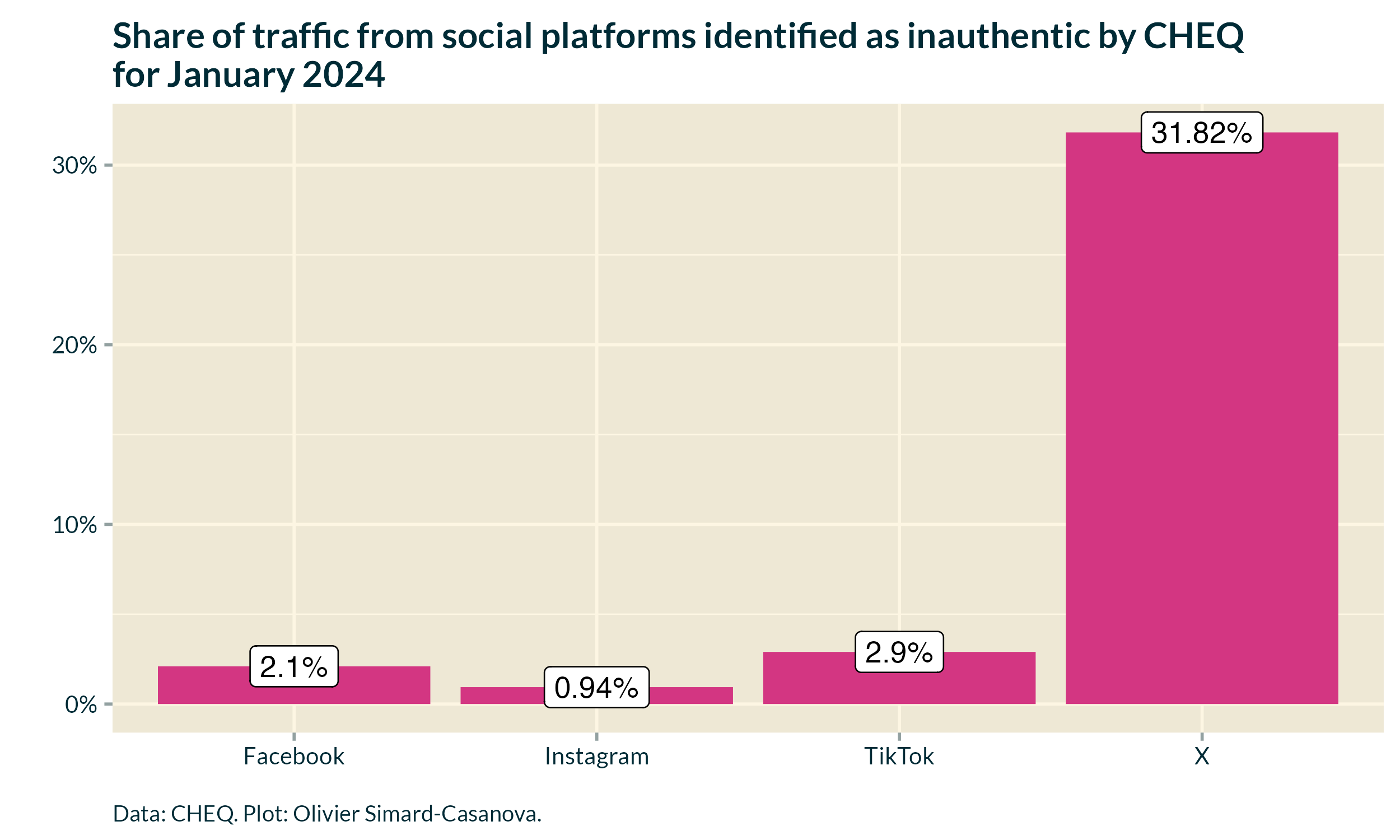Data illustrates that X, formerly Twitter, has a serious bot problem
Anyone who still uses X has experienced it: the platform is overwhelmed by inauthentic actors — namely, bots. Who hasn’t had a deluge of “Hannah” in their notifications for the last few months?
However, personal anecdotes are not enough to show that X has a generalized problem of inauthentic activity. To make such a claim, it is necessary to rely on data. A specialized company has just published such data. What the data shows is as shocking as it is catastrophic.
Last week, in the United States, the Super Bowl took place. It is a major American football event. This year’s edition broke audience records. Including on X, at least this is what the company said. However, to what extent was the activity on X during the Super Bowl human activity?
According to CHEQ, a company specialized in detecting inauthentic traffic and fighting online advertising fraud, during the 2024 Super Bowl, 75% of the traffic from X to its clients’ websites was made of bots. You read that right: three-quarters of the traffic monitored by CHEQ was inauthentic.

For comparison, here is the share of inauthentic traffic measured by CHEQ for other platforms:
- TikTok, Super Bowl 2024: 2.56%
- Facebook, Super Bowl 2024: 2.01%
- Instagram, Super Bowl 2024: 0.73%
- Twitter, Super Bowl 2023: 2.81%
I made two plots to illustrate the extent of the problem. Figure 1 shows the data above.

Figure 2 shows the same data as Figure 1, and I added the data for X for 2024.

I do not think I need to explain what differentiates Figure 1 from Figure 2.
CHEQ also published data on the share of inauthentic traffic for January 2024:
- TikTok: a little over 2.6%
- Facebook: a little over 2%
- Instagram: 0.96%
- X: 31.82%
Even outside major events like the Super Bowl, Figure 3 shows how X stands out by the considerable volume of inauthentic traffic that originates from the platform.

Here is what Guy Tytunovich, founder and CEO of CHEQ, says about the data:
I've never seen anything even remotely close to 50 percent, not to mention 76 percent. I'm amazed… I've never, ever, ever, ever seen anything even remotely close.
Two important methodological clarifications. The first is that we do not know if the data from CHEQ is representative: the data comes from the websites of the company’s clients, rather than a varied selection of websites. The second is that the data from CHEQ does not measure inauthentic activity directly on X. What the data from CHEQ measures is the proportion of the traffic from X to its clients’ websites that is not authentic.
With these clarifications in mind, the data from CHEQ nevertheless goes in the same direction of what many users of X have been reporting for months. If X generates so much inauthentic traffic to third-party sites, it implies that the inauthentic activity on the platform is significant.
At the very least, the data from CHEQ show that inauthentic activity on X has significantly increased: with a relatively constant methodology (the detection tools of CHEQ) and a relatively constant sample (the websites of CHEQ’s clients), the inauthentic traffic originating from Twitter in 2023, then from X in 2024, during the Super Bowl has been multiplied by… almost 27!

In addition to severely degrading the user experience, and thus further reducing the usefulness of the platform, the significant increase in inauthentic activity on X also creates a financial problem for the company. If advertisers buy ads, how do they know if said ads are seen by humans or by bots? Nobody is interested in buying ads and showing them to bots.
Fighting inauthentic activity was presented by Elon Musk as a major goal of his when he bought the company. It was for example with this goal in mind that he destroyed the identity verification system. Almost a year and a half later, it seems clear to me that inauthentic activity has not disappeared from X. Worse: the situation has deteriorated considerably. Any effort to correct course will undoubtedly be considerable, if it is ever undertaken.





